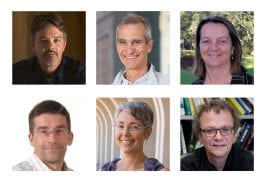In conflict with a long-held explanation of cadmium isotope motion, a new experiment found that cadmium-106 may rotate instead of vibrate.
Latest News
When Material Goes Quantum, Electrons Slow Down and Form a Crystal
Researchers detect an exotic electron phase called Wigner crystal in tungsten diselenide/tungsten disulfide moiré superlattices.
Machine Learning Takes Hold in Nuclear Physics
As machine learning tools gain momentum, a review of machine learning projects reveals these tools are already in use throughout nuclear physics.
A Trial Run for Smart Streaming Readouts
Nuclear physicists test whether next generation artificial intelligence and machine learning tools can process experimental data in real time.
A Plutonium Needle in a Haystack
New results could significantly improve resonance ionization mass spectrometry ultra-trace analysis of plutonium isotopes.
Natural instincts
Triple-scholarship recipient Kyle Suen furthers his love of nature through studies and research
Particles Pick Pair Partners Differently in Small Nuclei
Particles choose partners for short-range correlations differently when farther apart in light nuclei versus when packed closer together in heavy nuclei.
PREX, CREX, and Nuclear Models: The Plot Thickens
The results of parity-violating electron scattering experiments PREX and CREX suggest a disagreement with global nuclear models.
UC Irvine Earth system scientists plot pathways for climate-conscious air travel
Net-zero-emissions flying is possible by 2050 with new technologies and habits
American Association for the Advancement of Science honors six UC Irvine researchers
Scholars are recognized for their achievements in science and society











